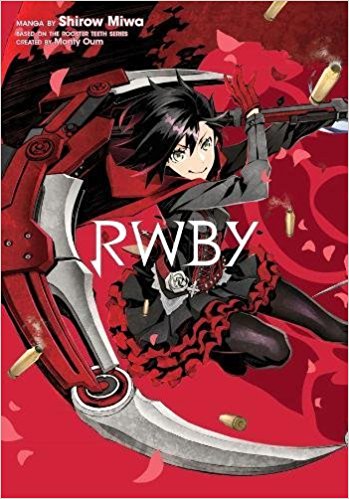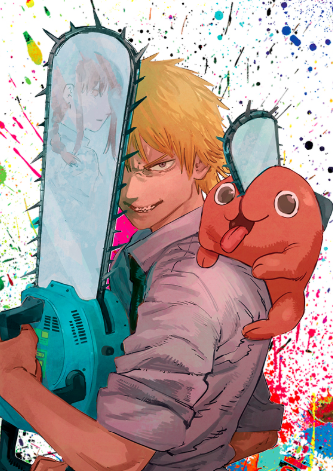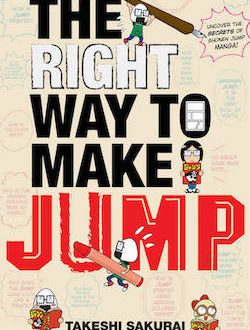There was a moment in the early 2000s when Tokyopop slapped the “manga” label on just about anything it published, from licensed Japanese comics to comics made by aspiring American artists who were trying to break into the industry. Looking back on the heated debate over the legitimacy of OEL manga, I wonder how today’s readers will view RWBY, a work that meets the basic definition of manga as “comics created in Japan,” but has a more complicated history than other American properties that have been reimagined for Japanese readers.
RWBY’s path to the Shonen Jump imprint began in 2013 when Rooster Teeth, an American production studio, had a viral hit with an original, anime-influenced show about a team of girls who fight monsters. Over the next four years, interest in RWBY was strong enough to inspire a spin-off series, a video game, four soundtrack albums, and a manga illustrated by Shirow Miwa, creator of Dogs and Dogs: Bullets & Carnage. Like Miwa’s other work, RWBY ran in the pages of Ultra Jump alongside JoJo’s Bizarre Adventure and Bastard!! before being licensed by VIZ for American readers.
Flipping through its pages, there are hints that RWBY is a slightly different animal than Jiro Kuwata’s Bat-Manga or Kia Asamiya’s Star Wars: The Phantom Menace. RWBY reads like a skillful imitation of a battle-heavy shonen manga, a riot of flying fists, kicking legs, swinging scythes, and extreme camera angles. Almost every imaginable visual cliche is on display, from a girl with cat-ears (she’s a Faunus, or a “therianthrope”) to a school uniform that consists of a waist-nipping blazer and impossibly short skirt. And while Miwa’s artistic persona is evident in the story’s best pages, RWBY feels less like a manga adaptation of a popular American show than a compendium of things that American fans like about anime and manga.
The story follows a familiar template: four — or three, or five — special teens attend a special school where they learn how to use their special powers to defend the Earth from demons or aliens. Each teen has one unusual gift — say, teleporting or making killer bento boxes — and one well-defined personality trait that dictates the costume she wears, how much she talks, and whether she plays well with others. Though individually effective, the quartet — or trio, or quintet — is more formidable when they team up against their shared enemy, a lesson that’s reinforced early and often in the series both in the outcome of the battle scenes and in the characters’ on-the-nose conversations about friendship and cooperation. In RWBY, the principal team consists of four girls: Ruby Rose, a weapons expert, Weiss Schnee, a rich girl, Blake Belladonna, a former gang member, and Yang Xiao Long, a cheerful spazz who loves a good brawl. All four attend attend Beacon Academy, where teens train to become Hunters, skillful warriors who wield cool weapons and magical spells against the Grimm, a race of “soulless monsters” that threaten humanity’s existence.
On the screen, such a shopworn premise could still work with the addition of snazzy animation, strong voice acting, great sound design, and judicious pacing. On the page, however, RWBY falls flat. Miwa is hamstrung by the pedestrian source material, cranking out a manga whose principal characters are blandly pretty and prone to explaining things to one another. Just a few pages into chapter one, for example, Ruby blithely asks her teammates about Dust, the magical substance that powers their weapons. Without missing a beat, Schnee responds, “It’s a crystallized energy propellant that helps to power our world.” She then launches into a lengthy rumination on Dust that’s supposed to reveal something about her character — her family’s fortune is tied to Dust — but is such a poorly disguised information dump that it never rises to the level of conversation.
Glimpses of Miwa’s signature style — his sharp-featured characters and spidery linework — emerge most clearly in the battle sequences, when Ruby and friends face off with the Grimm. Miwa frames the action in panels whose bold, diagonal boundaries mimic the combatants’ slashing motions and flying leaps. In one of the manga’s most striking sequences, Miwa traces a bullet from the barrel of Ruby’s gun towards its target. This kind of tracking shot is a hackneyed gesture, but Miwa does something playful and surprising with it: he breaks the frame to create the illusion that the bullet is emerging from the page and whizzing past the reader:
The rest of the sequence, however, is a hot mess. Miwa’s relentless shift in perspective makes the fight as incomprehensible as a badly edited car chase; it’s never clear how many monsters are involved, or what makes the Grimm so lethal, despite the fact that Miwa has tried to mimic the show’s swooping camera work to show the carnage from every possible angle.
Miwa’s indifference to the material also manifests itself in the almost total absence of background detail. Though he introduces the fight sequences with an establishing shot or two — a glimpse of trees, an aerial view of a railroad track — the action unfolds in blank space. Plenty of manga-ka take similar shortcuts, but when a manga is 70% combat and 30% character-building, the effect is like looking at a scene from The Last Jedi or Avatar before the special effects were added; in the absence of any objects, buildings, or landmarks that would contextualize their actions and words, the characters look downright silly.
Part of me wishes RWBY were better, as it’s fascinating to see an American program get the manga treatment, especially one that wears its Bleach and Magic Knight Rayearth influences on its sleeve. Ten years ago, fans would have derided such a program as inauthentic; today, it seems, such trans-Pacific exchanges are unremarkable. Too bad RWBY never escapes the prison of Overused Anime and Manga Tropes to become something more original, compelling, or entertaining.
RWBY • MANGA BY SHIROW MIWA • BASED ON THE ROOSTER TEETH SERIES CREATED BY MONTY OUM • TRANSLATED BY JOE YAMAZAKI, ADAPTED BY JEREMY HAUN & JASON HURLEY • VIZ MEDIA • 260 pp. • RATED T, FOR TEENS (Fantasy violence, mild fanservice)





Aaron says:
Kudos for criticising it as some refused to criticize the series original “Anime” adaptation after Monty Oum died. So to see some actually analyze and criticizes a portion of it is nice. Admittedly I’ve never been a fan of the franchise as it simply feels like someone’s half-baked fanfiction with their “Original Character, Do Not Steal”. That gained some sort of weird traction due to a mixture of sympathy by fans and odd corporate synergy.
Katherine Dacey says:
I know that Oum had passed away, but I wasn’t involved enough with the franchise to know that RWBY was supposed to be immune to critique because Oum wasn’t here to defend it. I think your summary captures exactly what’s wrong with RWBY; it feels like someone’s wicked cool anime fanfic, and not something that really stands on its own two feet.
Aaron says:
Not so much that RWBY is immune from criticism (although when Oum was alive that was a running joke on some forums) due to Oum’s passing and more that some felt RWBY could never be able to be improved. Feeling like it would be like criticizing a rough draft before it is reworked and polished into a final draft. Or a director’s Student Film
Which makes no sense to me since a professionally released Manga now exists and the Anime adaptation got simulcast by Netflix and Crunchyroll. The untimely demise of its creator does not shield a work from criticism. As that did not obviously stop anyone at Rooster Teeth, Crunchyroll, Shueisha, or Netflix from making new content based on it.
Also, I knew Shirow Miwa sounded familiar but really?! You are going to get the guy that wrote and drew Dogs: Bullets & Carnage to make this. I know it’s Ultra Jump but you could have gotten Shizuru Hayashiya (Hayate x Blade), or Kazushi Hagiwara (Bastard!!), or even Sayori Ochiai (Gingitsune).
But you went with the guy who drew the ultra grim-dark Noir-influenced high contrast black and white guns, violence, and fetish mutant Manga. Ok maybe it’s the only person you could get but it just feels off. Especially with the super bright colored boardering on self-parody source material.
AshLynx says:
Always a shame to see a show I really like get a poor adaptation to comics, but I guess it can really be expected. That one manga page was an absolute mess, but Oum really did have a talent for scripting combat scenes with CGI characters. Clearly something else the manga is missing is that his fight scenes knew they took place in an environment as pretty much every fight scene, without fail, used a part of the environment to its advantage. The fact that a fight scene took place in a forest, near a mountain, or an abandoned town actually meant something to the combatants (and fortunately even after Oum’s passing, the series is still amazing at it).
I am a fan of the original series though (I tried the “anime” version on Crunchyroll, it just felt like someone sucked all the oxygen out of the room). I’ve been watching since season 2 (before Oum’s passing) but it’s honestly only gotten better in recent seasons. If you haven’t seen the series, it adds more than just snazzy animation, strong voice acting, great sound design, and judicious pacing (though it certainly has those in spades), but it expands its lore slowly and deliberately and after the major events of season 3’s end, a lot of the characters are having to grow up develop and change, so we’re getting that too. I do recommend checking it out at some point (but not the “anime” version *shudder*)
Katherine Dacey says:
Hi, AshLynx! Based on all the anime adaptations I’ve read, I’d say it’s pretty difficult to do a good comic-book adaptation of an animated property. Some of the WORST titles VIZ and Tokyopop published were just such tie-ins — remember the Wolf’s Rain or Cowboy Bebop manga? At the same time, however, I understand why production studios like these kind of tie-in products, since there’s already a built-in audience for them.
As I’m sure it’s clear, I haven’t watched much of RWBY, but I might just give it another chance based on your recommendation.
AshLynx says:
I do recommend checking the show out, it’s a lot shorter than most anime, so it’s not as tough to find the time to set aside for it, thankfully. Season 1 is probably the shortest, at about 90 minutes or so, but the later seasons are 2.5-3 hours each. If you happen to get the blurays, there’s an option to just have it play straight through and not slow anything down with opening sequences all the time.
Seasons 1-3 do make a complete arc though, with season 4 starting the next arc (I think there’s 3 arcs planned, it seems Oum had written out a lot of the basic structure for the entire series before his passing). And thankfully, it seems they got more budget starting on season 2 (so background characters are no longer shadows, but have basic features, probably randomly generated, but they at least feel like they’re there now).
I think the worst manga tie-ins I’ve seen are Princess Tutu and Martian Successor Nadesico. Nadesico was just soulless, but Tutu seemed to do everything possible to distance itself from its excellent source material (I’m probably being extra harsh on it considering how much I adore the anime). I’m honestly blanking on ones that have been even approaching “acceptable”. I think the Gurren Lagann one was ok, what I read of it, but it was allowed to be more than 2 volumes long. It’s possible the Tiger & Bunny one is ok for the same reason.
I need to keep reminding myself that things like Re:Zero or A Certain Magical Index are actually adapted from light novels and that they and the anime both came from the same original source material. But the light novel adaptations I’ve read have been very good. Including those, there’s also stuff like Devil is a Part-Timer, Mushoku Tensei, Re:Monster, and plenty of others.